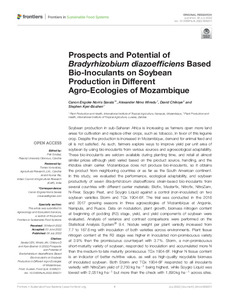| dc.contributor.author | Engoke, C. |
| dc.contributor.author | Wiredu, A.N. |
| dc.contributor.author | Chikoye, D. |
| dc.contributor.author | Boahen, S. |
| dc.date.accessioned | 2022-10-14T08:37:54Z |
| dc.date.available | 2022-10-14T08:37:54Z |
| dc.date.issued | 2022-07 |
| dc.identifier.citation | Engoke, C., Wiredu, A.N., Chikoye, D. & Boahen, S. (2022). Prospects and potential of bradyrhizobium diazoefficiens based bio-inoculants on soybean production in different agro-ecologies of Mozambique. Frontiers in Sustainable Food Systems, 6:908231, 1-16. |
| dc.identifier.uri | https://hdl.handle.net/20.500.12478/7869 |
| dc.description.abstract | Soybean production in sub-Saharan Africa is increasing as farmers open more land areas for cultivation and replace other crops, such as tobacco, in favor of this legume crop. Despite the production is increased in Mozambique, demand for animal feed and oil is not satisfied. As such, farmers explore ways to improve yield per unit area of soybean by using bio-inoculants from various sources and agroecological adaptability. These bio-inoculants are seldom available during planting time, and retail at almost similar prices although yield varied based on the product source, handling, and the rhizobia strain carrier. Mozambique does not produce bio-inoculants, so it obtains the product from neighboring countries or as far as the South American continent. In this study, we evaluated the performance, ecological adaptability, and soybean productivity of seven Bradyrhizobium diazoefficiens strain-based bio-inoculants from several countries with different carrier materials: Biofix, Masterfix, Nitrofix, NitroZam, N-Fixer, Soygro Peat, and Soygro Liquid against a control (non-inoculated) on two soybean varieties Storm and TGx 1904-6F. The trial was conducted in the 2016 and 2017 growing seasons in three agroecologies of Mozambique at Angonia, Nampula, and Ruace. Data on nodulation, plant growth, biomass nitrogen content at beginning of podding (R3) stage, yield, and yield components of soybean were evaluated. Analysis of variance and contrast comparisons were performed on the Statistical Analysis System® 9.4. Nodule weight per plant variedly increased from 7.7 to 167.6mg with inoculation of both varieties across environments. Plant tissue nitrogen content at the R3 stage was higher in inoculated non-promiscuous variety at 3.9% than the promiscuous counterpart with 3.7%. Storm, a non-promiscuous short-maturity variety of soybean, responded to inoculation and accumulated more N than the medium-to-late maturity promiscuous TGx 1904-6F. Higher N tissue content is an indicator of better nutritive value, as well as high-quality recyclable biomass of inoculated soybean. Both Storm and TGx 1904-6F responded to all inoculants variedly with NitroZam yield of 2,750 kg ha−1 being highest, while Soygro Liquid was lowest with 2,051 kg ha−1 but more than the check with 1,690 kg ha−1 across sites. There were varietal differences in 100-seed weight after inoculation where Storm (15.4 g) had heavier seeds than TGx 1904-6F (13.1 g). The results show that inoculation improved plant growth and development, increased nodulation, and gave higher yields for better economic returns among farmers. Inoculation has the potential of increasing soybean yield, nutritive value, and biomass quality within Mozambique. |
| dc.description.sponsorship | United States Agency for International Development |
| dc.format.extent | 1-16 |
| dc.language.iso | en |
| dc.subject | Soybeans |
| dc.subject | Grain Legumes |
| dc.subject | Nitrogen Fixation |
| dc.subject | Ecology |
| dc.subject | Nodulation |
| dc.subject | Rhizobiaceae |
| dc.subject | Yields |
| dc.title | Prospects and potential of bradyrhizobium diazoefficiens based bio-inoculants on soybean production in different agro-ecologies of Mozambique |
| dc.type | Journal Article |
| cg.contributor.crp | Grain Legumes |
| cg.contributor.crp | Maize |
| cg.contributor.affiliation | International Institute of Tropical Agriculture |
| cg.coverage.region | Africa |
| cg.coverage.region | Southern Africa |
| cg.coverage.country | Mozambique |
| cg.coverage.hub | Southern Africa Hub |
| cg.researchtheme | Plant Production and Health |
| cg.researchtheme | Social Science and Agribusiness |
| cg.isijournal | ISI Journal |
| cg.authorship.types | CGIAR Single Centre |
| cg.iitasubject | Agronomy |
| cg.iitasubject | Food Security |
| cg.iitasubject | Grain Legumes |
| cg.iitasubject | Nutrition |
| cg.iitasubject | Plant Breeding |
| cg.iitasubject | Plant Production |
| cg.iitasubject | Soybean |
| cg.journal | Frontiers in Sustainable Food Systems |
| cg.notes | Open Access Journal; Published online: 08 Jul 2022 |
| cg.accessibilitystatus | Open Access |
| cg.reviewstatus | Peer Review |
| cg.usagerightslicense | Creative Commons Attribution 4.0 (CC BY 0.0) |
| cg.targetaudience | Scientists |
| cg.identifier.doi | https://dx.doi.org/10.3389/fsufs.2022.908231 |
| cg.iitaauthor.identifier | Canon Norris Savala Engoke: 0000-0002-9667-2324 |
| cg.iitaauthor.identifier | Alexander Nimo Wiredu: 0000-0002-8487-4340 |
| cg.iitaauthor.identifier | David Chikoye: 0000-0002-6047-9821 |
| cg.iitaauthor.identifier | Stephen Boahen Asabere: 0000-0001-8946-401X |
| cg.futureupdate.required | No |
| cg.identifier.issue | 908231 |
| cg.identifier.volume | 6 |

